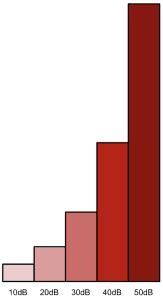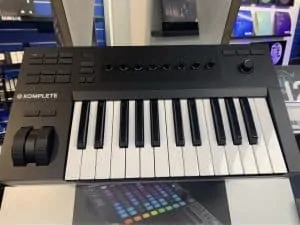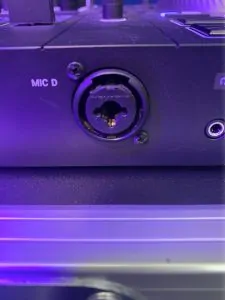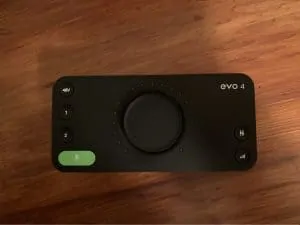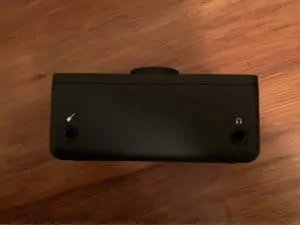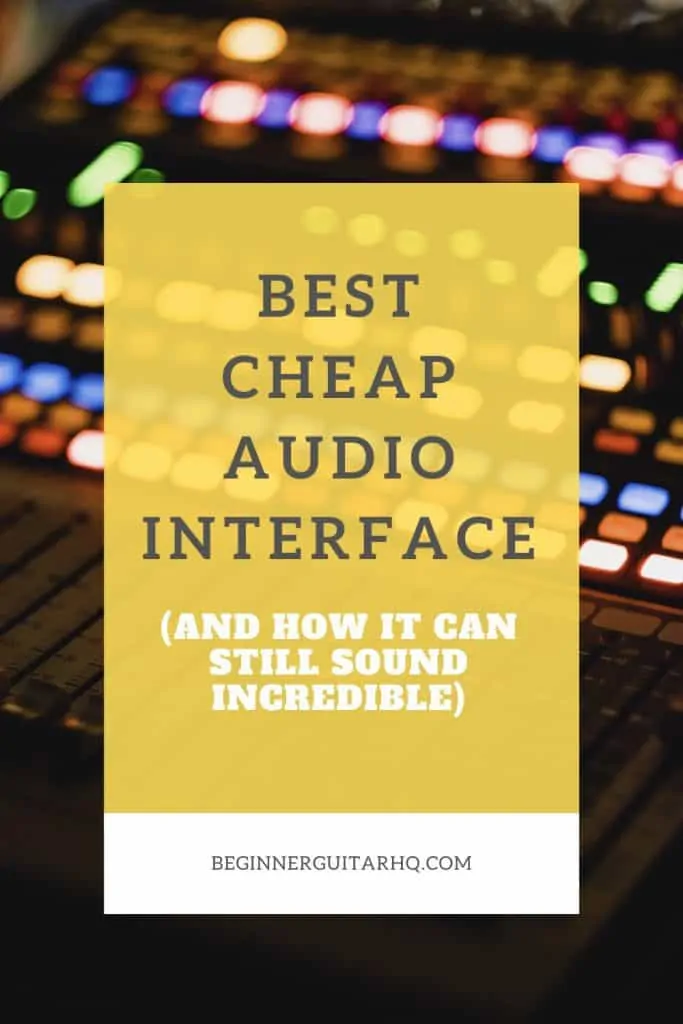So it’s come time to buy a cheap audio interface.
Whether you’re looking for your first ever interface, or you’ve been down this path a hundred times and find yourself needing a new audio box for whatever reason, there are countless options available.
The latter is the situation I found myself in recently, and I’m here to share with you what I learned while I was looking for a cheap audio interface, and why I ended up choosing the Audient Evo 4.
You see, I’ve had and used a number of interfaces over the years, from entry-level Akai boxes to full-on 8-channel rack-mounted Focusrite beasts, to 2-in 2-out pro-grade desktop interfaces from the likes of Audient, Apogee, and Universal Audio.
I’ve been interfaceless for a few months while traveling and working remotely, and as I found myself back in my home country due to recent world events, I found myself needing a new audio interface.
I’ve been borrowing a Focusrite Scarlett 2i4 2nd gen which has been doing the trick, but it’s getting a bit tired and is running into the odd tech issue.
Focusrite Scarlett 2i4 Gen 2
So, it was time for a new interface, and my decision to buy a reasonably cheap one was dictated by two reasons:
- Available funds (obviously)
- My experience in using both high-end and cheap interfaces, and knowing that the difference, for the most part, is minimal
I’m going to dive into why I chose the Audient Evo 4, but first, for those of you just getting started in the world of recording and audio interfaces:
Contents
What Is An Audio Interface?
Interfaces can be a scary and confusing world to get into if you’re new to recording. They come in a range of shapes, sizes, and designs, and it’s not immediately obvious what’s going on inside the box.
Let’s break it down.
There are two fundamental components to an audio interface:
- Mic preamps
- Analog to digital converters
Regardless of the type of microphone you’re using, whether it’s a dynamic or a condenser or a ribbon mic, you’ll need to be plugging that baby into a microphone preamp.
That’s because the output level of a microphone is tiny, and it’s just not enough for any kind of audio device to use.
A mic preamp lifts that mic output by between 20-60dB (typically), which is a huge difference when you realize that every 10dB is a doubling in perceived volume. That means that a 50dB boost to a mic signal is the same as making it 32 times louder.
Decibel Scale
The second main component in a cheap audio interface, or any interface for that matter, is the analog to digital converters. Commonly referred to as A/D or A-D converters, this smart little gizmo does exactly what the name says: taking the analog signal from the mic preamp and turning it into 1s and 0s so that your computer can make sense of it.
Now, these two components can be bought separately, though it’s really only done in pro-audio and studio recording environments. Most of the rest of us opt for the all-in-one flexibility of an audio interface.
Everything else an audio interface offers can differ, you might see a variety of headphone outputs, line inputs, and various controls and switches, but they are all negotiable, to a degree. I’ll get into those features shortly and let you know what to look out for.
Who Needs An Audio Interface?
Pretty much anyone who wants to record music!
That said, there are a few workarounds.
For example, if you have a USB microphone, then you won’t need an audio interface to record with it because it has one built-in.
If you have a MIDI keyboard with a USB output, this can plug directly into your computer without the need for an audio interface either.
MIDI Keyboard
However, if you want to record with a standard XLR microphone, plug your guitar or bass straight in and use amp simulators, or record the line outputs of your favorite synth, then you’ll need a cheap audio interface at the very least.
What To Look For In An Audio Interface
Not every cheap audio interface is made the same.
Though they all include the basics (at least one mic preamp, and AD converters), they often differ in many other ways.
Here’s what you want to be looking out for:
Inputs
You’ll want to be on the lookout for two things here: how many inputs the interface has, and what kind of input they are.
There are four main types of inputs you’ll find on cheap audio interfaces:
- Microphone
- Line
- Instrument
- MIDI
Mic inputs are the most common, and pretty much every cheap interface will have at least one, if not two of these. You’ll see this type of input using an XLR jack.
Both line and instrument inputs use the ¼” jack format, so it can be easy to mistake the two. The type of signal the input is expecting to see differs between line and instrument types, so these are not interchangeable. Many interfaces use the same jack and feature a line/instrument switch, so look out for this, or for the term ‘hi-Z’ which is synonymous for instrument input.
Often, cheap interfaces use what is known as a combi jack, which is an XLR input with a ¼” input in the center. This way they can keep costs down and take up less real estate, but still provide you with the ability to choose between mic and line inputs. Often, they are mic/line/instrument inputs – the best of all three worlds.
Combi XLR Jack
The last kind of input you’ll find is the 5-pin MIDI jack, which is for connecting MIDI controllers and instruments like drum pads or synths. If you don’t use this kind of equipment, don’t worry about it. If you do, or think you might, however, then having a MIDI input is invaluable, especially for analog gear that doesn’t interface via USB MIDI.
Outputs
Literally every cheap audio interface has at least one set of stereo outputs for hooking up your monitors, and these are typically on ¼” jack or RCA outputs.
Some higher-end interfaces have further line outputs for connecting to outboard gear or for dual monitoring setups.
You’ll also generally see at least one stereo headphone output jack, though some offer two or more!
Lastly, expect to see a MIDI output whenever you see an input.
Connectivity
The device you plan on using with your interface is going to have a hand in dictating which cheap interface you should buy.
Most of them use USB, and generally, they ship with USB A-type connectors. Some of the newer models use USB-C cables, which is handy for MacBook users like myself.
USB C Cable
Occasionally, you’ll see Thunderbolt or Firewire connection, though these are typically found on more expensive interfaces.
Phantom Power
It’s rare to find an audio interface without 48v phantom power these days, even a cheap one, however, it’s important to make sure, because you’ll need it if you plan on recording with a condenser microphone.
Why I Chose The Audient Evo 4
Like I mentioned, I’ve owned and worked with a number of interfaces, from cheap ones to expensive ones, and though I’m typically a bit of a gear snob, I’ve found there to be little noticeable difference between the two types.
So, I decided to save my cash for other gear like a nice new guitar, and opt for a cheap audio interface.
My first instinct was to go for a Focusrite Scarlett 2i2, or maybe the Clarett 2Pre. Mostly because the 2i2 is kind of the go-to cheap interface these days, I’ve used them plenty before, and they do exactly what I need.
Then I remembered something I’d seen recently on Instagram, something really sexy.
No, it wasn’t an Insta-model or influencer, it was the Evo 4.
Audient Evo 4 Top
I’d been hit with a targeted ad, and for once it was actually relevant and timely. I remembered seeing a sharp, sleek, single-knob black box desktop interface with some smart LEDs and some incredibly cool tech, and I remember thinking to myself, this is the next big thing in cheap interfaces.
Comparing the Evo 4 with the industry-standard 2i2, it has the same number and type of inputs and outputs, though the 2i2 has instrument inputs on both channels and the Evo 4 only has one on channel one. That didn’t worry me though, ‘cause I can only play one guitar at a time!
Audient Evo 4 I/O
Both have a single headphone output with direct monitoring, and 48v phantom power on both channels.
The AIR feature on the Focusrite box was tempting. It emulates the famous ISA preamps which I do love, however, I was happy to forego this analog feature as, to be honest, I have enough analog-modeling goodness with the Slate Digital plugin suite.
The Scarlett 2i2 is the more well-featured of the two then, so what won me over?
- The small form factor
- The one-knob design and clear metering
- The Smartgain function
- The price!
Desktop interfaces are pretty small as they are, but the Evo 4 really takes it up a notch.
Or, is it, down a notch?
Anyway, I loved the fact that the Evo 4’s longest dimension was only 5.5 inches, roughly the size of my iPhone. The box it comes in is super small as well, and I’ve been able to pack the whole thing in my carry-on baggage without any concern for weight or size limits.
Audient Evo 4 Size
The second thing that got me was the one-knob design, doing away with tonnes of small knobs and buttons and flashing LEDs, and opting for a single large knob in the center of the interface that controls everything.
It’s really nicely notched, super tactile and intuitive, and best of all, the LED metering is accurate and doesn’t lack clarity like some other cheap audio interfaces. Overall, I’m really stoked with the aesthetic design of this box, it’s super classy.
One thing the Audient Evo 4 incorporates is their new Smartgain function, which automatically sets the input gain for optimal recording levels.
Now, I don’t tend to have any problems setting gain levels myself, so I wouldn’t exactly call this function a life-saver, but it’s still pretty cool and speeds up your workflow. You just press the button while you’re playing or singing, and the Evo 4 automatically detects the ideal input level.
YouTube Video: Audient Evo 4 Audio Interface Review / Explained (Smart Gain Demo)
Input levels are more important than you might think, as if you get it wrong you could be setting yourself up for failure when it comes time to mix, so I’d definitely recommend this as a feature for beginner musicians and recording artists.
Last, but certainly not least when hunting for a high-quality, but cheap audio interface, is the price.
The Audient Evo 4 came in a good 25% less than the Scarlett 2i2, despite offering pretty much everything the Scarlett does, and being, in my opinion, a more beautiful and user-friendly device.
That’s why I chose the Audient Evo 4, plus the fact that it sounds amazing, just as good as many pro-level interfaces I’ve used in the past.
Don’t believe me?
How Can A Cheap Audio Interface Sound So Great?
If you’re out searching for a cheap audio interface, you’ve probably come across a forum or two, and you’ve been exposed to the myriad of opinions for audio-elites and gear snobs shunning cheap interfaces.
Here’s the thing:
Is a more expensive interface better than a cheap one?
Yeah, probably.
Objectively, they’ll have ‘better’ preamps, ‘better’ quality components, and ‘better’ analog to digital converters.
But the real question is, just how much better are they?
If you were to do a side by side shoot out of the Evo 4 vs. the Apogee Duet, then yeah, you’ll probably notice a difference.
But that difference will be marginal, and to be honest probably doesn’t justify the Duet costing more than 4x as much as the Evo…
And, when you actually pit them together in a real life scenario, with layers and layers of tracks with reverb, effects, compression and EQ on them, then that marginal difference becomes pretty much imperceivable.
Let me show you what I mean.
This is a track I recorded a few years back when I had the Focusrite Liquid Saffire 56, and insanely powerful (for it’s time) 8-channel Firewire interface, that cost in the range of $1300 USD when it came out.
[Example Recorded with Focusrite Liquid Saffire 56]
As a comparison, this is a little something I laid down recently using my Audient Evo 4, which is about one tenth of the price of the LS56.
[Example Recorded with Audient Evo 4]
There’s really not much difference, is there?
Now, bear in mind these are both raw tracks without any mixing or mastering, and they are both using Logic’s built-in drummer.
To give you an example of something in between, this was recorded on my old Audient ID22, which is around $500 USD.
[Overboard by Take Hold, recorded on the Audient ID22]
Hopefully then, it’s become clear to you that you can create incredibly professional recordings using a cheap audio interface, an expensive pro-level unit, or anything in between!
5 More Best Cheap Audio Interfaces
I chose the Audient Evo 4 because it was the perfect cheap audio interface for my needs, but everyone’s needs differ.
That’s why there are so many different cheap interfaces on the market, and that’s why I’ve decided to include 5 more interfaces that might be better suited to your specific situation.
Focusrite Scarlett 2i2
I have to say, I’ve been a huge fan of Focusrite since day one in my audio journey. Everything they create is of incredible quality, and it’s usually quite affordable.
It’s this combination of factors that has skyrocketed the Scarlett 2i2 to stardom, and it’s the reason this is most people’s go-to interface.
The Scarlett 2i2 is in its third generation now, and this latest model is by far the best there has been.
That’s because the preamps use Focusrite’s amazing AIR tech, which models the sound of their famed ISA preamp, perhaps one of the most coveted and sought after preamps on the market.
Aside from that, it’s pretty much a standard 2-in 2-out interface.
| What’s in the box? | |
| Inputs | 2x combi mic/XLR/instrument jacks |
| Outputs | 1 set of stereo line outputs (for speakers) |
| Headphone outputs | 1x on the front panel with level control and direct monitoring |
| Phantom power | Yes |
| Connectivity | USB |
| What’s unique? | Focusrite AIR preamps |
Native Instruments Komplete Audio 1 & 2
If you’re anything like me, you’ve been following Native Instruments for a few years now.
I’m a bit of a fanboy, to be honest, I use Kontakt ALL the time, I’m a huge fan of their Maschine controllers and Komplete Kontrol keyboards, and the samples, synths, and software instruments they create are just insane.
When I saw they were bringing out a range of cheap interfaces, though, I wasn’t immediately convinced.
Perhaps it’s the inner audiophile snob in me, but I’ve always felt that audio interface production should remain in the pro-audio realm, with prosumer companies (like NI) left to their own devices, as it were.
Like I said though, I’m a bit of a fanboy, so I thought I’d give them a chance.
Turns out, they’re pretty damn nice.
The Komplete Audio 1 features just a single XLR input, and it’s output jacks are on RCA, which is a bit low-budget for my liking. The Komplete Audio 2 steps things up a notch with full-size output jacks and a second XLR input (combi), bringing it in line with offerings like the Evo 4 and Scarlett 2i2.
For me, I see two big selling points with the Komplete range.
The first is that if you’re already deeply invested in NI gear and have a Komplete Kontrol or a Maschine, then it’s nice to keep everything clean and in-line from a design perspective. It just makes your studio look cool.
The second point really only matters if you’re NOT a Native Instruments user: you get some sick plugins. Komplete Start is a production suite with 16 synths and sampled instruments, as well as effects, loops, and samples. I also really loved that the chucked in the Solid Bus Comp compressor plugin as it’s one of my favorite compressors to use on a drum mix.
| What’s in the box? | |
| Inputs | Komplete Audio 1 – 1x XLR, 1x jack (line/inst)
Komplete Audio 2 – 2x combi mic/XLR/instrument jacks |
| Outputs | Komplete Audio 1 – stereo RCA
Komplete Audio 2 – 1 set of stereo jacks |
| Headphone outputs | 1x on the front panel with level control and direct monitoring |
| Phantom power | Yes |
| Connectivity | USB |
| What’s unique? | Included software: Ableton Live 10 Lite, Maschine Essentials, Komplete Start, Monark, Phasis, Replika, Solid Bus Comp |
PreSonus Studio 24c
PreSonus’ interfaces have long been a staple in the recording field, though their previous generations of interface like the AudioBox have often lost out to competitors like Focusrite.
For their new generation of audio interface (the studio range), PreSonus has amped things up a notch.
The Studio 24c has all the things you’d expect in a 2-in 2-out interface, but where it really shines is its 192kHz sampling capabilities, and the fact that it’s USB-C compatible, which is ideal for users of newer MacBooks.
The input LEDs are endlessly helpful for getting your signal levels right and not mucking up your gain staging, and what’s more, the Studio 24c comes with PreSonus’ Studio One Artist music production software, which will save you splashing out on an expensive DAW.
Here’s the kicker though:
The PreSonus Studio 24c has MIDI i/o built-in, which means you can connect a MIDI device like a synth or controller and use it with the included music production software.
So yeah, the name ‘studio’ is well earned.
| What’s in the box? | |
| Inputs | 2x combi mic/XLR/instrument jacks
1x MIDI |
| Outputs | 2x balanced ¼” TRS main outputs
1x MIDI |
| Headphone outputs | 1x on the rear panel with level control and direct monitoring |
| Phantom power | Yes |
| Connectivity | USB |
| What’s unique? | Includes PreSonus Studio One Artist music production software. |
Steinberg UR12
Speaking of DAW creators branching out into audio interfaces, the Steinberg UR12 is a solid cheap audio interface for those aiming to keep costs low.
Steinberg are the creators of Cubase, which is one of the longest-running DAWs to exist and is used by music producers and film scorers alike – even Hans Zimmer is a long-time proponent.
Why does this matter?
Well, it means you know that Steinberg knows audio inside and out.
And to help budding musicians and recording artists like yourself lay down a couple of tracks into Cubase (or whatever else you’re using), they built the UR12.
The UR12 has a single mic input, so it’s really suitable for a singer or rapper, or anyone who only needs to use one mic at a time. No stereo-miking options here.
There is a second input, though it’s an instrument only input.
So this might be a good option for singer-songwriters, as you can plug your guitar into the hi-Z input and your vocal mic into input 1.
Aside from that, there’s not too much to mention. The UR12 just does a really good job of being a simple audio interface. It’s built like a tank too with its all-metal casing, so I’d have no concerns taking this guy out on the road.
| What’s in the box? | |
| Inputs | 1x XLR input
1x hi-Z instrument jack |
| Outputs | 1x stereo RCA output |
| Headphone outputs | 1x on the front panel with direct monitoring but no level control |
| Phantom power | Yes |
| Connectivity | USB |
| What’s unique? | Built like a tank |
Behringer U-Phoria UMC22
Last on our list of cheap interfaces is the Behringer U-Phoria UMC22.
Behringer’s claim to fame is their extensive range of cheap guitar pedals that do an excellent job, but when the company acquired Midas And Klark Teknik, their pro-sound journey really began.
Their X32 mixing console is one of the most commonly used digital mixers in live sound today, and the UMC22 is an incredible interface that’s cheap as heck and sounds amazing.
It’s a single mic-input interface, using Midas designed mic preamp, so you know your recordings are going to sound fantastic.
You get ¼” monitor outputs, which is always good to see on a cheap interface like this, and you even get an instrument input on channel two, which makes this cheap little black box perfect for guitarists and singers alike.
| What’s in the box? | |
| Inputs | 1x XLR input
1x hi-Z instrument jack |
| Outputs | 2x ¼” jack outputs |
| Headphone outputs | 1x on the front panel with direct monitoring but no level control |
| Phantom power | Yes |
| Connectivity | USB |
| What’s unique? | Midas designed mic preamp |
Conclusion
So, there you have it, 6 solid choices for a cheap recording interface, and proof that they can still sound absolutely incredible.
Obviously, I’m biased toward the Audient Evo 4, and if you can’t decide between any of the excellent cheap interfaces on this list, then that’s the one I’d be going for.
It is hands down the sleekest and sexiest interface on the market, it’s intuitive, tactile, and well-designed.
Oh, and it sounds brilliant, which is kind of what matters the most…


